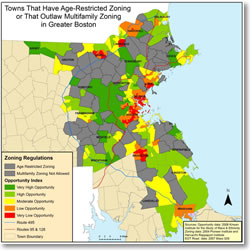1970s–Present: Age-Restricted Housing
Despite large minimum lot size requirements, many communities make exceptions for multi-family housing and single-family housing on small lots for residents who are 55 or older. Communities promote age-restricted housing for a variety of reasons. Senior housing is usually more readily accepted by existing residents than regular multi-family housing because of the reduced levels of automobile traffic, the maturity of the residents, and the realization that such housing is needed to accommodate the increasing number of seniors.
For example:
- Chelmsford’s Master Plan states: “senior housing is usually more readily accepted by existing residents more than regular multi-family housing because of the reduced levels of automobile traffic, the maturity of the residents, and the realization that such housing is needed to accommodate the increasing number of seniors.” (Dain).
- Lynnfield’s Master Plan notes in the Economic Development Section: “Another means of increasing the tax base in Lynnfield is development of age-restricted housing. These developments have a positive fiscal impact because they do not produce school-aged children.” (Ibid)
What is the impact of age restricted housing on segregation?
Although not an explicitly discriminatory tactic, age-restricted zoning, by not allowing residents under the age of 55, has an implicit and inequitable impact on families with children—a protected class under the Fair Housing law. Age-restricted housing also has a disparate impact on minorities because 48% of minority households in Boston have children, vs. 32% of white households.
A study of 187 greater Boston municipalities revealed:
- 96 of the municipalities within 50 miles of Boston have zoning for age-restricted housing
- 64 have special provisions for multifamily housing that is age restricted (Dain).
The intersection of age restricted housing and minimum lot sizes
Minimum lot size requirements are also more lenient for age-restricted housing. Of those studied, the 60% of municipalities in greater Boston with large minimum lot size requirements of 20,000 square feet have some sort of provision for age-restricted housing, and more than 40% with minimum lot sizes greater than 35,000 square feet have provisions that allow for age-restricted multifamily housing.
Specific example of recent project with age-restricted housing:
Westwood Station
Westwood Station is a 135-acre, transit-oriented, mixed-use development to be located adjacent to the MBTA/Amtrak Station in Westwood. This project incorporates Smart Growth planning principles to create a vibrant community, featuring a live, work, shop, dine, and play destination in a pedestrian-friendly atmosphere.
The residential component of Westwood Station includes 500 units and is not geared towards families. The Westwood Station community bulletin website in 2008 originally described the residential component of the project as being “naturally targeted to young professionals and empty-nesters, populations with very few school-aged children. The development will feature amenities and designs that are more appealing to these populations and lifestyles….because the residential component will be targeted to empty nesters and young professionals, we believe there will be little additional stress on town services.” This language has subsequently been removed from the bulletin although the residential component has not materially changed.


